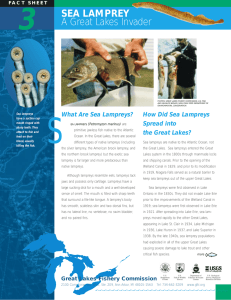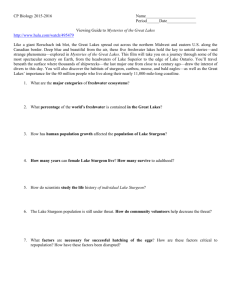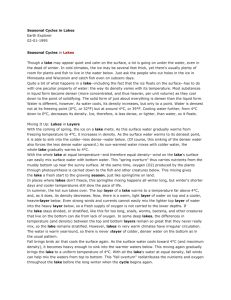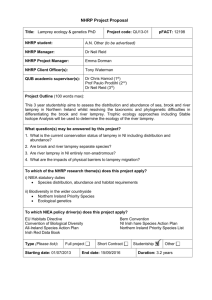HERE - Reduce Risks from Invasive Species Coalition
advertisement
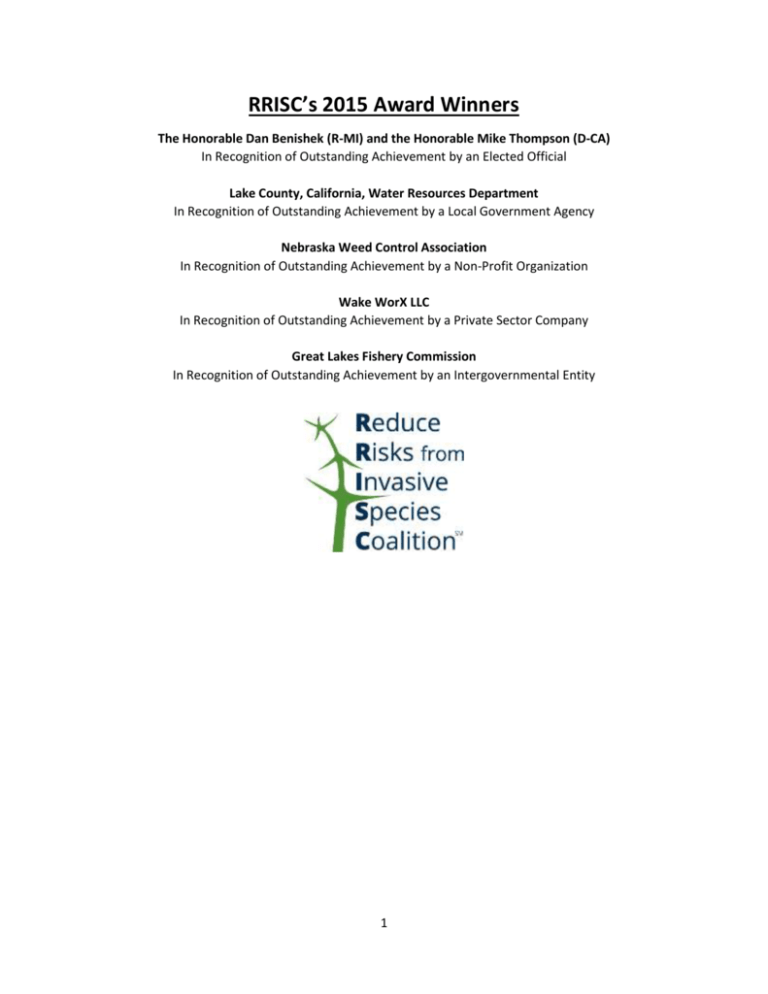
RRISC’s 2015 Award Winners The Honorable Dan Benishek (R-MI) and the Honorable Mike Thompson (D-CA) In Recognition of Outstanding Achievement by an Elected Official Lake County, California, Water Resources Department In Recognition of Outstanding Achievement by a Local Government Agency Nebraska Weed Control Association In Recognition of Outstanding Achievement by a Non-Profit Organization Wake WorX LLC In Recognition of Outstanding Achievement by a Private Sector Company Great Lakes Fishery Commission In Recognition of Outstanding Achievement by an Intergovernmental Entity 1 Lake County, California, Department of Water Resources Clear Lake is located approximately 3 hours north of the San Francisco Bay Area in the coastal mountain region between the Pacific Ocean and the Sacramento Valley. At over 43,700 surface acres, it is the largest natural freshwater lake entirely in California – Lake Tahoe is larger, but a portion of the lake is in Nevada. Clear Lake is renowned for its black bass fishery and it’s annually voted one of the top bass fishing lakes in the nation. As a destination lake for amateur and top fishing pro’s alike, Clear Lake receives thousands of visiting fishermen from all over the Country. With 110 miles of shoreline and over 700 private access ramps, a lake-access control program presents a myriad of issues, so the effort over the past eight years has been boater education. The Lake County Department of Water Resources, the County Department charged with the management of the invasive species prevention program, has developed a unique program for the roughly 6,000 resident boats and 10,000 visitor boats. Resident boaters are issued a sticker on an annual basis and they are reminded through press releases and social media that new stickers are required at the start of a new year. Non-residents receive monthly stickers, and each pay $10. Resident boaters are encouraged to follow safe boating practices and make sure their boats are “Clean, Drained and Dry” if they take their boats outside of the County. A free cleaning service is also offered to all resident boaters if they are concerned that have visited a lake with invasive mussels. Non-resident boaters fill-out a screening form where the answers to simple questions help identify what level of risk that boat presents and any boat that meets certain factors is referred to a trained inspector or to the County for cleaning. Any boat found on the lake without a current sticker faces a minimum of an Administrative Citation that starts at a $100 fine, up to a misdemeanor citation with a $1000 fine. What’s unique about this program is the partnership that has been created between the County and the businesses that offer the screening services. These locations are mostly tackle shops and resorts, and between all the locations they offer screening 7 days per week around the lake. “Screeners” receive annual training on the program and the role they play. Duplicate screening forms are collected and reviewed monthly for compliance, and occasionally additional training is conducted if a pattern of noncompliance becomes evident. There are approximately 30 screening locations around the lake, and each takes pride in being part of the program. For their role as the “front line” of the program, the screening location receives $7 of the $10 sticker sale, with the County receiving the remaining portion. Though sometimes criticized for not providing a physical barrier to the lake, the logistics and financial requirement of such a control program almost dictate an educational effort. In an effort to expand the current program, the County staff has been successful in obtaining grant funds from the State of California to implement a seasonal ramp monitoring effort and that is expected to begin in July, 2015. For more information: http://www.nomussels.com/ 2 “To encourage and develop better weed control practices” www.neweed.org The Nebraska Weed Control Association has been active since its organization on June 30, 1959. At the time it was organized, there were only weed districts, and they were only in counties that desired to have a weed control district. This group began working toward creating a law that would make weed control compulsory in every county in the state, as well as promote the profession and professionalism of the weed superintendent. Amendments made to the Noxious Weed Control Act in 1989 required that all 93 counties in Nebraska have a weed superintendent. Today we have a very active Association, with all 93 counties participating. In 1990, Nebraska had 4 State listed Noxious weeds, with 3,987,914 acres being reported by counties as having infestations. In 2014, with 12 State designated Noxious weeds, the infested acres have dropped to 1,093,011 as reported by county Superintendents. The success of the weed program in Nebraska is due to our Superintendents actively inspecting lands in their counties and educating landowners about weed control and the cost of doing nothing. We have implemented an Early Detection Rapid Response (EDRR) program that has proven to be the most cost efficient way of managing new invasive plants, allowing us to control infestations before they get out of hand. Weed Management Areas (WMA’s) were formed to provide neighboring counties to join together to work on larger weed control projects. These WMA’s also began looking for public as well as private entities to partner with, and today Nebraska has 13 WMA’s across the state. Many large projects have seen great success since 2007, when the Nebraska Legislature passed bills allocating 4 Million dollars to help control invasive vegetation in Nebraska’s riparian corridors. Allocated money was distributed to WMA’s through the Nebraska Department of Agriculture. The money allowed work to be done, but also allowed local WMA’s to match State money with local partners and other grant sources. From 2007-2014 the 4 Million was parlayed into 18 Million dollars for work on the ground. Partners include Nebraska Environmental Trust, Nebraska Legislature, NE Department of Ag, NRCS, NRD’s, the Platte River Recovery and Implementation Program, as well as numerous Federal, State and Local grants. These generous partners and the funding provided was instrumental in starting work in the riparian zones to increase flow conveyance, increase wildlife habitat, and increased water availability for human uses by reducing consumption from invasive vegetation. Since 2007, and the allocation of the 4 Million dollars, over 2800 miles along Nebraska’s rivers and streams have been treated for invasive vegetation. The control of Noxious and Invasive Species in Nebraska continues due to the dedication of the professional County Weed Superintendents of our State. 3 Scott and MaryKate Wood have spent the last four years growing their start-up marine supply company, Wake WorX. They manufacture one-of-a-kind ballast -pump kits, wake-surf systems and the ONLY Aquatic Invasive Species Ballast Filter System, Mussel Mast’R. Having learned of the great devastation caused by boaters transporting Quagga and Zebra Mussel larvae, via ballast tanks/bags and live/bait wells, they knew that they needed to help. With decades of design experience, vision, innovation and science Mussel Mast’R was created, tested and developed. Extensive research conducted by Dr. Sudeep Chandra, Limnology Professor at University of Nevada Reno, proved the Mussel Mast’R highly effective in filtering out Quagga and Zebra Mussel veligers, Asian Clams, New Zealand Mud Snails, Water Fleas, Eurasian Water Milfoil and other microscopic AIS. Through a collaborative and very successful private/public partnership with the TRPA; Tahoe Regional Planning Agency, PSMFC; Pacific States Marine Fisheries Commission, WSIA Water Sports Industry, Colorado Parks &Wildlife, CA Fish & Game and the WPR; Western Regional Panel, Mussel Mast’R was brought to the boating public. In a 2014 press release supporting Mussel Mast’R technology, the Tahoe Regional Planning Agency AIS Program Coordinator Dennis Zabaglo stated “Aquatic Invasive Species can devastate native species and entire waterway. This is a big step forward in saving our lakes and waterways giving boaters the tools they need to protect the waters they use.” Additionally, in 2014, Centurion and Nautique Boat Companies joined the “Stop Aquatic Hitchhiker” cause and started offering the Mussel Mast’R on their 2015 model year boats. Additionally, Wake WorX offers systems at boat dealerships nationwide as a retro-fitable after market kit. The introduction of the Mussel Mast’R Aquatic Invasive Species to the marketplace has already proven to be a positive technology both economically and environmentally. Since 1987, the United States Government has spent in excess of $5Billion in AIS prevention and containment efforts. The Mussel Mast’R system as already benefitted multiple inspection and decontamination stations in regard to saving on expenditures spent on water, time and staff. The dramatic threat of transporting AIS from lake to lake is drastically lessened by each and every boat that has Mussel Mast’Rs installed. For more information please contact MaryKate at www.wake-worx.com 4 Great Lakes Fishery Commission Sea Lamprey Control in the Great Lakes A remarkable success! The sea lamprey is an incredibly destructive invasive species. Since entering Lake Ontario in the mid-1800s, and the upper Great Lakes beginning in 1921, sea lampreys have inflicted significant economic damage, harmed the fishery and ecosystem, and changed the way of life in the region. Sea Lamprey A Great Lakes Invader describes the devastating impact of sea lampreys on the Great Lakes. Of the more than 180 non-native species in the Great Lakes basin, sea lampreys are the only invader that is controlled basin-wide and is the only example in the world of a successful aquatic vertebrate pest control program at an ecosystem scale. Sea lampreys must be controlled to maintain and improve the fishery as we know it and to protect the integrity of the ecosystem. The good news is they can be controlled! The Great Lakes Fishery Commission, pursuant to the Convention on Great Lakes Fisheries, delivers sea lamprey control in partnership with the U.S. Fish and Wildlife Service, Fisheries and Oceans Canada, and the U.S. Army Corps of Engineers. The U.S. Geological Survey conducts critical sea lamprey research to aid in control. This control program has reduced sea lamprey populations by 90% in most areas of the Great Lakes, a remarkable success! How are sea lampreys controlled? Sea lampreys spend a significant portion of their lives in tributaries as filter feeding larvae, so sea lamprey control begins when biologists assess tributaries to determine which ones contain larval sea lampreys. Larval assessment is critical in determining the presence, distribution, size structure, and abundance of larval sea lampreys in infested tributaries. This information helps the commission decide where and when control should be implemented. Sea lamprey control works because the commission has several tools available to significantly knock-down the populations. 5 The commission and its partners maintain an "integrated" sea lamprey control program that combines several control methods to attack sea lampreys on many fronts. These methods include: Lampricides The primary method to control sea lampreys is the application of the lampricide TFM to target sea lamprey larvae in their nursery tributaries. In the concentrations used, TFM kills larvae before they develop lethal mouths and migrate to the lakes to feed on fish, while most other organisms are unaffected by TFM. TFM disrupts energy metabolism in sea lampreys, which have low levels of the enzymes used to eliminate TFM from their bodies. Another compound called Bayluscide is less costly and during some treatments, a liquid or powdered form of Bayluscide is combined with TFM to reduce the amount of TFM needed during treatments. Additionally, a granular form of Bayluscide, consisting of Bayluscidecoated grains of sand covered with a time-release coating, is applied to slow-moving or stationary waters where it sinks to the bottom before releasing its payload. This enables control of larvae in areas where TFM cannot be used. About 200 Great Lakes tributaries and larval "hot spots" are regularly treated with lampricides to kill larvae before they have a chance to prey on fish. See Lampricides and Sea Lamprey Control for more information. Barriers To successfully reproduce, sea lampreys require access to tributaries containing spawning gravel and soft substrates for larval sea lampreys to burrow into. The jumping ability of adult sea lampreys is limited, so barriers function to block adult access to spawning habitat and, therefore, reduce the amount of habitat that sea lampreys can infest. In addition to power generating and other dams, low-head barriers specifically designed to block adults have been constructed in strategic locations around the Great Lakes. Most low-head barriers allow jumping fish to pass while other barriers incorporate "trap and sort" fishways, which 6 permit the passage of non-jumping species (trapped sea lampreys are removed). Barriers have reduced or eliminated the need for lampricide treatments in thousands of miles of tributaries. See fact Sea Lamprey Barriers for more information. Traps Sea lampreys are vulnerable to capture as adults when they move into tributaries to spawn or as juveniles when they move out of tributaries to prey on fish. Adult traps are typically built into or placed immediately downstream of sea lamprey barriers and capture up to 40% of the adult population from a tributary. Unfortunately, traps typically do not capture a high enough proportion of the adult population to eliminate reproduction entirely or the subsequent need for lampricide treatments. Nevertheless, trapping provides a critical way to assess adult populations and gauge the success of the sea lamprey control program. Juvenile traps are typically free-standing, removable nets or other devices that target sea lampreys before they kill fish. See Sea Lamprey Traps and The Future of Sea Lamprey Control for more information. Pheromones and alarm cues Sea lampreys have an extremely keen sense of smell, and since the 1990s, the commission and its research partners have been developing ways to exploit that sense for sea lamprey control. Pheromones and alarm cues are natural odors organisms use to affect certain behaviors or physiological functions. Sea lampreys emit pheromones to attract adults to suitable spawning tributaries and to mates within the tributary. Alarm cues emanate from dead or injured sea lampreys and warn other sea lampreys of impending danger, causing a flight response. Together, pheromones and alarm cues could be used in a "push-pull" technique - luring adults to traps, unsuitable spawning habitat, and areas that are easy and inexpensive to treat with lampricides, and repelling them from areas with productive spawning habitat and areas where control tactics are hard or expensive to implement. See The Future of Sea Lamprey Control for more information. The fishery depends on sea lamprey control. Fish are part of the fabric of the Great Lakes. 7 The Great Lakes fishery is worth more than $7 billion annually to people. The fishery supports 75,000 jobs, in addition to hundreds of thousands of jobs related to tourism, navigation, etc. More than 5 million people fish the Great Lakes annually. Commercial fishing is the backbone of many Great Lakes communities. Charter fishing is an important business. Subsistence fishing is a right and a way of life for tribal and aboriginal communities. Sea lamprey populations have been reduced to a fraction of what they were before control began, creating conditions for the recovery of native and desirable fishes and the ecosystem. Today, agencies stock hundreds of millions of trout and salmon into the lakes, enhancing the resource. Sea lamprey control must continue. Sea lamprey control is a major contributor to the value of the Great Lakes fishery. Sea lampreys are resilient beasts. When control is relaxed for even a short time, they bounce back with a vengeance and inflict major harm. Elevated sea lamprey abundances take years to remedy and higher populations set back fishery and ecosystem recovery by decades. Robust, ongoing control is essential. History shows that with fewer fish, the region’s economy and environment suffer greatly: More sea lampreys mean a degraded ecosystem, increased damage to the fish community, and fewer fish. The people who depend on the $7 billion fishery suffer economically when sea lampreys prey on Great Lakes fish. 8 Waterfront communities decay and people move away. More sea lampreys jeopardize tribal treaty obligations. For more information: http://www.glfc.org/aboutus/brief.php 9
